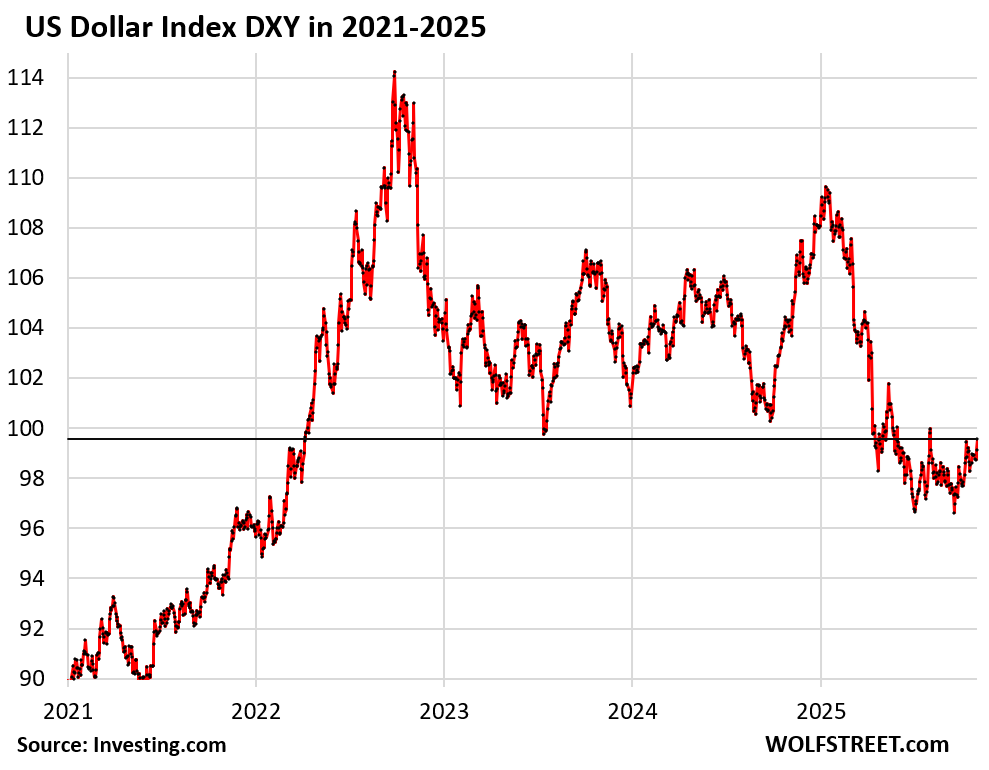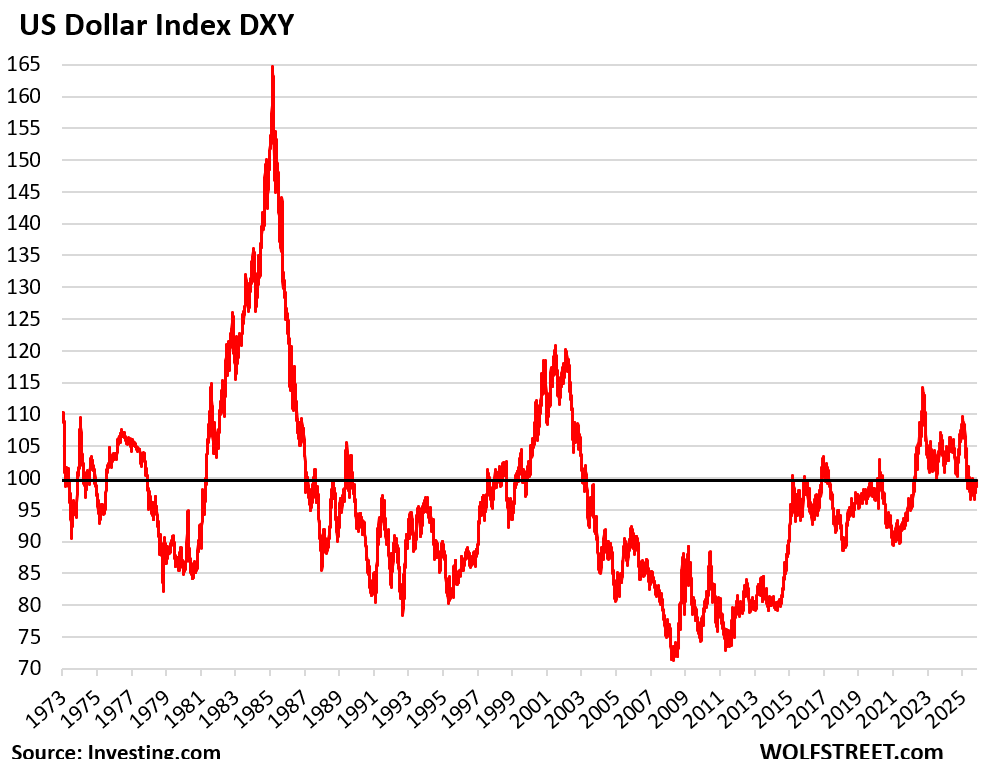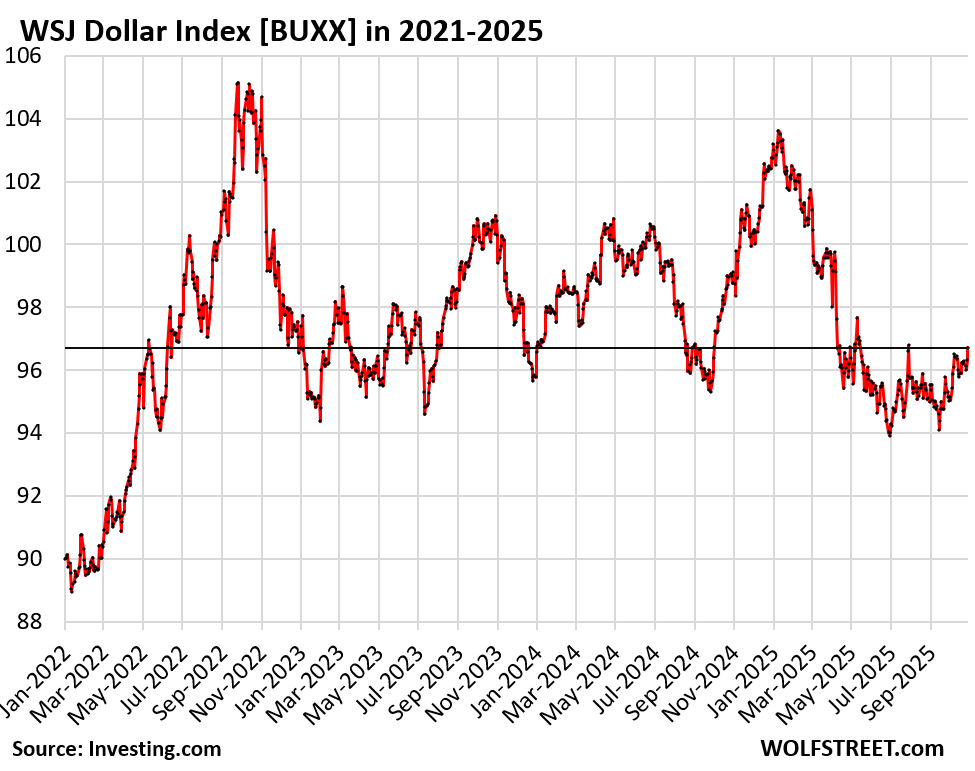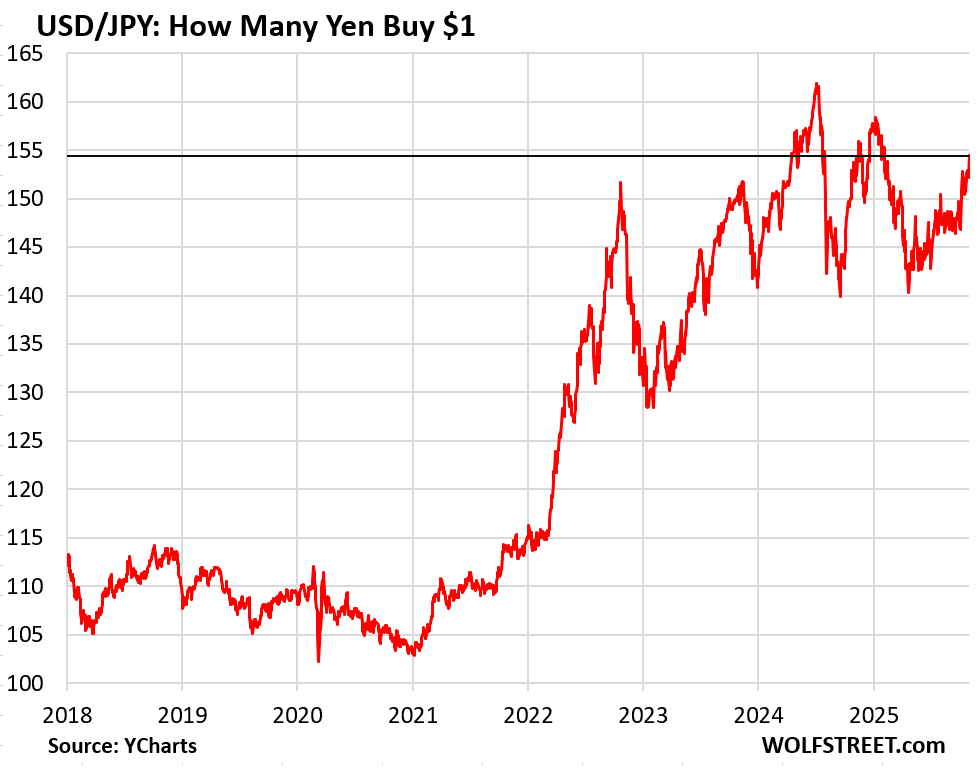But the much-hyped USD “debasement trade” already died weeks ago. The correct debasement trade has been the yen.
By Wolf Richter for WOLF STREET.
The US dollar was already zigzagging higher against other currencies since the intensely hyped “debasement trade” had died a few weeks ago. Then Powell threw more fuel on the dollar yesterday by shedding doubts on the already taken-for-granted rate cut in December.
The debasement-trade promos in the financial and social media had exhorted people to pile into cryptos, gold, silver, and sometimes even stocks because government borrowing and money printing would rapidly erode the value of the US dollar. As in all these trades, if enough people follow, prices of the targeted instruments would explode, at least for a little while, and people that could get out in time would make lots of money.
But the huge bond market brushed off the debasement trade, and the dollar started zigzagging higher in late September. Then came Powell.
“A further reduction in the policy rate at the December meeting is not a forgone conclusion, far from it,” Powell said in his prepared remarks at the FOMC press conference yesterday.
Then, in response to a question, he said: “So, we are at a place where we’ve cut two more times. Now we are 150 basis points closer to neutral, whatever that may be, than we were a year ago. There is a growing chorus now of feeling like maybe this is where we should at least wait a cycle.”
Upon which the dollar rose further against other currencies and continued that way today.
The DXY Dollar Index [DXY] rose 0.4% yesterday and again 0.4% today to 99.6, the highest since the brief spike at the end of July, and before then the highest since May. The DXY tracks the USD against the euro, yen, British Pound, Canadian dollar, Swedish krona, and Swiss franc.

The long view of the DXY going back to its beginning in the early 1970s shows that this level of the dollar is just where it had been when the DXY index was introduced.
The dollar had been far lower against these currencies for many years during that time, and far higher for some years.
The years 2022, 2023, and 2024 were among the highwater marks, with December 31, 2024 being the high of the year. And in the first half of 2025, the DXY declined from those relatively high levels on December 31.
The decline from December 31 through June 30 was far from being the biggest six-month decline in 50 years, as had been wrongly stated in the debasement trade promos for manipulative purposes. There were many six-month declines that were bigger, including in 2023 and 2020. But by coincidence of the calendar, it was the biggest decline from a December 31 through a June 30.

The WSJ Dollar Index [BUXX], which is far broader than the DXY, rose by 0.4% yesterday and 0.5% today, to 96.7, the highest since the brief spike at the end of July, and before then the highest since May.
The BUXX is trade-weighted and tracks the USD against the 16 currencies of the Euro Area, Japan, China, Canada, Mexico, South Korea, Taiwan, India, Hong Kong, Singapore, UK, Australia, New Zealand, Norway, Switzerland, and Sweden.

The Fed’s policy interest rates, at 3.75% to 4.0%, are among the highest of the developed economies. They’re about double the ECB’s key rate of 2.0%. The BOJ at its meeting today held its key policy rate at 0.5%, barely above ZIRP, despite inflation accelerating and running at about the same pace as in the US.
As a result of the BOJ’s willfully lax policy, the yen has been getting crushed. The yen today dropped to ¥154 to the USD, the worst since February. Over the past five years, the yen lost 35% of its value against the USD. That has been the proper debasement trade for years.

Enjoy reading WOLF STREET and want to support it? You can donate. I appreciate it immensely. Click on the mug to find out how:
![]()


1:04 PM 10/30/2025
Dow 47,522.12 -109.88 -0.23%
S&P 500 6,822.34 -68.25 -0.99%
Nasdaq 23,581.14 -377.33 -1.57%
VIX 17.26 +0.34 2.01%
Gold 4,032.80 +32.10 0.80%
Oil 60.22 -0.26 -0.43%
Look at Gold for dollar debasement trade. Many dollars have died as the “GOLDEN STANDARD” still stands
I’m curious as to how much longer can the yen perform like this until treasury sell off happens. 35% is brutal and their debt to gdp is relatively high for modern economies.
“Our currency, your problem”
Sounds like an advertisement from you Wolf for folks to take a trip to Japan with USD. Wolfstreet conference in Tokyo 2026?
not an ad but reality!
However Au closed (again) over $4000/troz so the debasement trade has not been minimalized as per SoCal’s post!
It feels really strange to me that Japan has become a budget-travel destination for people with USD and EUR incomes, given how ridiculously expensive it was when I went there first in 1996.
Mortgage rates spike!
Stock market bubble update: S&P 500 market cap now 58.21 Trillion, with the weighting of the top seven tech stocks currently 35.91% of the index.
Whenever the music stops, the SPY and the QQQ will collapse under their own WEIGHTINGS.
So you are saying that NVIDIA is not worth the entire economy of Germany?
The repo facility shows a tightening of monetary policy beginning September 15. This corresponds to the strengthening of the US $
In my opinion, a stronger dollar can contribute to the unwinding of basis trades, especially when combined with rising Treasury yields and shifting global capital flows. The unwinding would likely be accelerated and magnified since basis trades are typically leveraged.